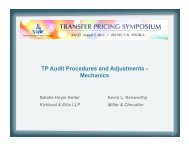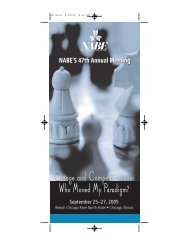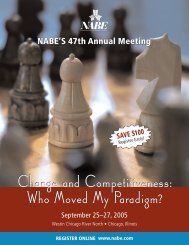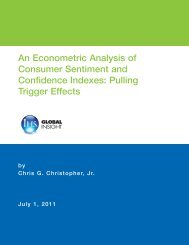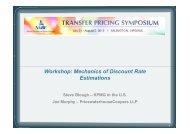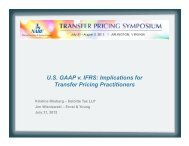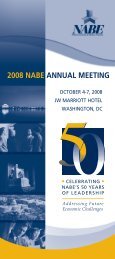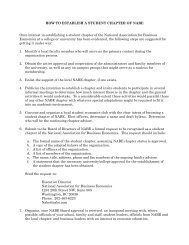Seminal Court Cases and Their Impact on Transfer Pricing ... - NABE
Seminal Court Cases and Their Impact on Transfer Pricing ... - NABE
Seminal Court Cases and Their Impact on Transfer Pricing ... - NABE
You also want an ePaper? Increase the reach of your titles
YUMPU automatically turns print PDFs into web optimized ePapers that Google loves.
<str<strong>on</strong>g>Seminal</str<strong>on</strong>g> <str<strong>on</strong>g>Court</str<strong>on</strong>g> <str<strong>on</strong>g>Cases</str<strong>on</strong>g> <str<strong>on</strong>g>and</str<strong>on</strong>g> <str<strong>on</strong>g>Their</str<strong>on</strong>g> <str<strong>on</strong>g>Impact</str<strong>on</strong>g> <strong>on</strong><br />
<strong>Transfer</strong> <strong>Pricing</strong> Practice <str<strong>on</strong>g>and</str<strong>on</strong>g> Procedure<br />
Rocco Femia, Miller & Chevalier<br />
John Magee, Bingham McCutchen<br />
Irving Plotkin, PWC<br />
1
Agenda<br />
• Overview of seminal transfer pricing cases<br />
• Less<strong>on</strong>s learned<br />
• Applicati<strong>on</strong> – Xilinx <str<strong>on</strong>g>and</str<strong>on</strong>g> Veritas<br />
• Implicati<strong>on</strong>s for future transfer pricing litigati<strong>on</strong><br />
2
Caveat Lector<br />
• Decided transfer pricing cases are intensely factual<br />
• <str<strong>on</strong>g>Court</str<strong>on</strong>g>s sometimes appear to adopt methodologies<br />
driven by desire to reach result somewhere between<br />
positi<strong>on</strong> of two parties<br />
• Limit to less<strong>on</strong>s that can be drawn from cases<br />
• Virtually all transfer pricing disputes are resolved<br />
short of litigati<strong>on</strong><br />
3
U.S. Steel (2d Cir. 1980, rev’g Tax <str<strong>on</strong>g>Court</str<strong>on</strong>g>)<br />
Primacy of Internal CUPs<br />
• USP purchased shipping services from FSub<br />
• Prices equal to prices charged to unc<strong>on</strong>trolled<br />
companies for shipping of much smaller quantities<br />
• USP could have procured services for less<br />
• <str<strong>on</strong>g>Court</str<strong>on</strong>g> adopts internal CUP analysis<br />
• C<strong>on</strong>sider viability of decisi<strong>on</strong> post 1994 regulati<strong>on</strong>s<br />
<str<strong>on</strong>g>and</str<strong>on</strong>g> “realistic alternatives” st<str<strong>on</strong>g>and</str<strong>on</strong>g>ard<br />
4
du P<strong>on</strong>t (Ct. Cl. 1979, aff’g Ct. Cl. trial dec. 1978)<br />
Use of Financial Ratios<br />
• USP sold goods to distributor (FSub)<br />
• At trial, taxpayer justified prices based <strong>on</strong> resaleminus<br />
analysis <str<strong>on</strong>g>and</str<strong>on</strong>g> <strong>on</strong> industry-average gross margins<br />
• IRS experts noted FSub’s relatively low selling costs<br />
over net sales, <str<strong>on</strong>g>and</str<strong>on</strong>g> other differences with comps<br />
• IRS experts supported IRS adjustment with analyses<br />
based <strong>on</strong> operating margin <str<strong>on</strong>g>and</str<strong>on</strong>g> return <strong>on</strong> capital<br />
• <str<strong>on</strong>g>Court</str<strong>on</strong>g> sustains IRS adjustment <str<strong>on</strong>g>and</str<strong>on</strong>g> foreshadowed<br />
multiple features of modern transfer pricing analysis<br />
5
Hospital Corp. of America (Tax <str<strong>on</strong>g>Court</str<strong>on</strong>g> 1983)<br />
<strong>Transfer</strong> of Business Opportunities<br />
• USP formed FSub to perform under c<strong>on</strong>tract with<br />
unc<strong>on</strong>trolled party<br />
• Most substantial work d<strong>on</strong>e by USP<br />
• IRS argued that all profits of FSub should be<br />
reallocated to USP<br />
• <str<strong>on</strong>g>Court</str<strong>on</strong>g> rejects argument that transfer of business<br />
opportunity required allocati<strong>on</strong> of all resulting profits<br />
• <str<strong>on</strong>g>Court</str<strong>on</strong>g> resorts to profit split to allocate 75% of FSub<br />
income back to USP<br />
6
Bausch & Lomb (2d Cir. 1991, aff’g Tax <str<strong>on</strong>g>Court</str<strong>on</strong>g> 1989)<br />
Respect for Transacti<strong>on</strong>s as Structured<br />
• USP moved low-cost manufacturing capability (<str<strong>on</strong>g>and</str<strong>on</strong>g><br />
related manufacturing IP) to FSub<br />
• Products sold back to USP priced per external CUPs<br />
• Royalty for manufacturing process based <strong>on</strong><br />
projected profitability of FSub<br />
• IRS argued that FSub should be compensated for its<br />
functi<strong>on</strong>s as c<strong>on</strong>tract manufacturer<br />
• <str<strong>on</strong>g>Court</str<strong>on</strong>g> rejects IRS approach, adopts CUP analysis,<br />
but increases royalty to split projected profits 50/50<br />
7
Westreco (Tax <str<strong>on</strong>g>Court</str<strong>on</strong>g> 1992)<br />
Limited Returns for Limited Risk<br />
• USSub performed R&D services for FP,<br />
compensated <strong>on</strong> a cost-plus basis<br />
• IRS initially used “salary multiplier” method, <str<strong>on</strong>g>and</str<strong>on</strong>g> then<br />
financial data of “comparable” companies in same SIC<br />
code, to justify adjustment<br />
• <str<strong>on</strong>g>Court</str<strong>on</strong>g> rejects IRS positi<strong>on</strong> because data did not<br />
account for reduced risk undertaken by USSub, am<strong>on</strong>g<br />
other differences<br />
8
Compaq (Tax <str<strong>on</strong>g>Court</str<strong>on</strong>g> 1999)<br />
C<strong>on</strong>structed CUPs (or Prices vs. Profits)<br />
• USP moved low-cost manufacturing process to FSub<br />
• Products sold back to USP priced per cost plus<br />
• At trial, USP justified prices based <strong>on</strong> prices paid to<br />
unc<strong>on</strong>trolled suppliers for similar products in<br />
c<strong>on</strong>signment (rather than buy/sell) arrangements<br />
• Adjustments to CUPs > CUPs<br />
• IRS argued that profitability of FSub was too high<br />
based <strong>on</strong> functi<strong>on</strong>s<br />
• <str<strong>on</strong>g>Court</str<strong>on</strong>g> rejects IRS approach, adopts CUP analysis<br />
9
UPS (11th Cir. 2001, rev’g in part T.C. 1999)<br />
Business Purpose <str<strong>on</strong>g>and</str<strong>on</strong>g> <strong>Transfer</strong> <strong>Pricing</strong><br />
• USP charged “excess value charge” to customers to<br />
insure packages<br />
• USP restructured operati<strong>on</strong>s by reinsuring EVC with<br />
foreign affiliate (through unc<strong>on</strong>trolled intermediary)<br />
• IRS argued that arrangement had no business<br />
purpose <str<strong>on</strong>g>and</str<strong>on</strong>g> should be shammed; Tax <str<strong>on</strong>g>Court</str<strong>on</strong>g> agrees<br />
• Eleventh Circuit disagrees, <str<strong>on</strong>g>and</str<strong>on</strong>g> recasts issue as a<br />
transfer pricing issue (e.g., the appropriate<br />
compensati<strong>on</strong> for reinsurance)<br />
10
DHL (9th Cir. 2002, aff’g & rev’g in part T.C. 1998)<br />
Scope <str<strong>on</strong>g>and</str<strong>on</strong>g> Ownership of IP<br />
• USP transferred WW trademark to foreign affiliate<br />
• Tax <str<strong>on</strong>g>Court</str<strong>on</strong>g> fixes value of IP <str<strong>on</strong>g>and</str<strong>on</strong>g> similar attributes at<br />
$300M, or value of business above book value<br />
• Tax <str<strong>on</strong>g>Court</str<strong>on</strong>g> allocates IP value 50/50 as between WW<br />
trademark rights (compensable) <str<strong>on</strong>g>and</str<strong>on</strong>g> transferee<br />
delivery network (not compensable)<br />
• Ninth Circuit further holds that transfer of foreign<br />
trademark rights are not compensable because they<br />
were already “owned” by transferee<br />
11
Xilinx (9th Cir. 2010)<br />
• USP <str<strong>on</strong>g>and</str<strong>on</strong>g> FSub are parties to cost sharing<br />
arrangement<br />
• USP does not reflect stock opti<strong>on</strong>s in cost pool<br />
• Taxpayer proffers evidence that parties in similar<br />
arrangements do not share stock opti<strong>on</strong> expense<br />
• IRS expert argues that failure to share would lead to<br />
distorti<strong>on</strong> of income<br />
• Ninth Circuit ultimately holds for taxpayer <strong>on</strong> basis of<br />
evidence from arm’s length dealings<br />
• 2003 regulati<strong>on</strong>s intended to reverse holding<br />
12
Veritas (Tax <str<strong>on</strong>g>Court</str<strong>on</strong>g> 2009)<br />
• USP enters into cost sharing arrangement with FSub<br />
• USP transfers pre-existing IP for buy-in payment<br />
• USP defends buy-in payment based <strong>on</strong> CUT analysis<br />
with reference to unc<strong>on</strong>trolled licenses of same IP<br />
• IRS expert argues that transfer was akin to sale of<br />
foreign business <str<strong>on</strong>g>and</str<strong>on</strong>g> should be compensated by<br />
expected future profits under income method<br />
• <str<strong>on</strong>g>Court</str<strong>on</strong>g> holds in favor of taxpayer, but requires<br />
adjustments to CUTs<br />
• 2009 regulati<strong>on</strong>s explicitly adopt income method<br />
13
Xilinx <str<strong>on</strong>g>and</str<strong>on</strong>g> Veritas<br />
• Decisi<strong>on</strong>s in Xilinx <str<strong>on</strong>g>and</str<strong>on</strong>g> Veritas are not aberrati<strong>on</strong>s<br />
• <str<strong>on</strong>g>Court</str<strong>on</strong>g>s often rely <strong>on</strong> actual unc<strong>on</strong>trolled transacti<strong>on</strong>s<br />
even where comparability is tenuous<br />
• <str<strong>on</strong>g>Court</str<strong>on</strong>g>s often reject IRS efforts to recast transacti<strong>on</strong>s<br />
• <str<strong>on</strong>g>Court</str<strong>on</strong>g>s often reject IRS arguments based <strong>on</strong> broad<br />
principles rather than facts at issue<br />
• Allocati<strong>on</strong>s of rights to earn income in the future may<br />
not be compensable<br />
• Showing of “undue” profit may not be enough where<br />
transacti<strong>on</strong>al analysis supports result<br />
14
Future of Tax Litigati<strong>on</strong><br />
• Outside of cost sharing, virtually no cases decided<br />
under modern (1994) regulati<strong>on</strong>s<br />
• Virtually all transfer pricing disputes decided under<br />
framework of regulati<strong>on</strong>s short of litigati<strong>on</strong><br />
• APA <str<strong>on</strong>g>and</str<strong>on</strong>g> competent authority programs provide an<br />
outlet to address potentially c<strong>on</strong>tentious arrangements<br />
• IRS has established <strong>Transfer</strong> <strong>Pricing</strong> Practice to<br />
better coordinate h<str<strong>on</strong>g>and</str<strong>on</strong>g>ling of key cases <str<strong>on</strong>g>and</str<strong>on</strong>g> identify<br />
emerging issues<br />
15



